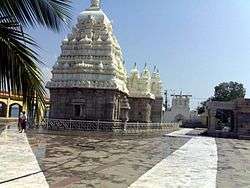Kalachuris of Kalyani
| Kalachuri dynasty of Kalyani | ||||||||||||
| ||||||||||||
| Capital | Kalyani (Basavakalyana) | |||||||||||
| Languages | Kannada | |||||||||||
| Religion | Hinduism Buddhism Jainism | |||||||||||
| Government | Absolute monarchy | |||||||||||
| History | ||||||||||||
| • | Established | 1156 CE | ||||||||||
| • | Disestablished | 1181 CE | ||||||||||
| ||||||||||||

The Kalachuris of Kalyani were a 12th century Indian dynasty, who ruled over parts of present-day North Karnataka and Maharashtra. This dynasty rose to power in the Deccan region between 1156 and 1181 CE.
The rulers of the dynasty traced their origins to one Krishna, who is said to have conquered Kalinjar and Dahala in present-day Madhya Pradesh (see Kalachuris of Tripuri). Bijjala, a viceroy of the dynasty, is said to have established the authority over Karnataka after wresting power from the Chalukya king Taila III. Bijjala was succeeded by his sons Someshvara and Sangama but after 1181 CE, the Chalukyas gradually retrieved the territory. Their rule was short and turbulent and yet very important from a socio-religious point of view; a new sect known as the Lingayat or Virashaiva sect was founded during these times.[1]
A unique and purely native form of Kannada literature-poetry called the Vachanas was also born during this time. The writers of Vachanas were called Vachanakaras (poets). Many other important works like Virupaksha Pandita's Chennabasavapurana, Dharani Pandita's Bijjalarayacharite and Chandrasagara Varni's Bijjalarayapurana were also written.
Origin
The Kalachuris of Kalyani overthrew the Kalyani Chalukyas in the early part of the 12th century, and had a relatively short but stormy rule.[2] The name "Kalachuri" is shared by multiple earlier dynasties, two of which ruled in central India. Some historians such as Dr. P.B. Desai believe that the southern Kalachuris of Kalyani are descendants of these central Indian dynasties. In the 6th century, before the rise of the Badami Chalukyas, the Kalachuris of Mahishmati had carved out an extensive empire covering areas of Gujarat, Malwa, Konkan and parts of Maharashtra. However, after their crippling defeat at the hands of Chalukya Mangalesha, they remained in obscurity for a prolonged period of time. Subsequently, the Kalachuris of Tripuri and their branches rose to power in central India.
A 1174 CE record says the Kalyani Kalachuri dynasty was founded by one Soma who grew beard and moustache to save himself from the wrath of Parashurama, and thereafter the family came to be known as "Kalachuris", Kalli meaning a long moustache and churi meaning a sharp knife. They migrated to the south and made Magaliveda or Mangalavedhe (Mangalavada) their capital. They titled themselves Kalanjara-puravaradhisvara ("Lord of Kalanjara"), which indicates their central Indian origin. Their emblem was Suvarna Vrishabha or the golden bull. They must have started as modest feudatories of the Chalukyas of Kalyani. They were also referred to as Katachuris (shape of a sharp knife) and Haihaya (or Heheya).
The later records of the dynasty claim that they descended from Brahma, the Creator of the universe.
As feudatories of Chalukyas
The early Kalachuris of the south were Jains and encouraged Jainism in their kingdom. The first notable chief of the Kalachuri family of Karnataka was Uchita. While there were several kings who followed him ruling as feudatories of the Kalyani Chalukyas, it was Jogama who became an influential vassal of Vikramaditya VI, being related to the great Chalukya king by matrimony.
Decline Of Kalachuris
The Southern Kaluchuri kingdom went into decline after the assassination of Bijjalla. The rulers who followed were weak and incompetent, with the exception of Sovideva, who managed to maintain control over the kingdom. Western Chalukyas ended the Kalachuri Dynasty. Many Kalachuri families migrated to Kanara districts of Karnataka. The Kalachuris are the principal characters in the Andhra epic The battle of Palnadu.
Rulers
| Part of a series on the |
| History of Karnataka |
|---|
|
| Categories |
|
- Uchita
- Asaga
- Kannam
- Kiriyasaga
- Bijjala I
- Kannama
- Jogama
- Permadi
- Bijjala II (1130–1167): proclaimed independence in 1162.
- Sovideva (1168–1176)
- Mallugi --> overthrown by brother Sankama
- Sankama (1176–1180)
- Ahavamalla (1180–1183)
- Singhana (1183–1184)
Inscriptions and coinage
As per the 1163 CE inscription which records a religious offering (mahadana) in the presence of Hampi Lord Virupaksha by Bijjala the Kalachuri King.[3]
The Southern Kalachuri kings minted coins with Kannada inscriptions on them.
Notes
- ↑ Students' Britannica India By Dale Hoiberg, Indu Ramchandani.
- ↑ "Chalukyas of Kalyana (973- 1198 CE)". Retrieved 2009-03-31.
- ↑ "The cosmic site of Vijayanagara". ABHA NARAIN LAMBAH. Retrieved 2009-04-01.
References
- Dr. Suryanath U. Kamath (2001). A Concise History of Karnataka from pre-historic times to the present, Jupiter books, MCC, Bangalore (Reprinted 2002)
External links
| Wikimedia Commons has media related to Kalachuri Empire. |